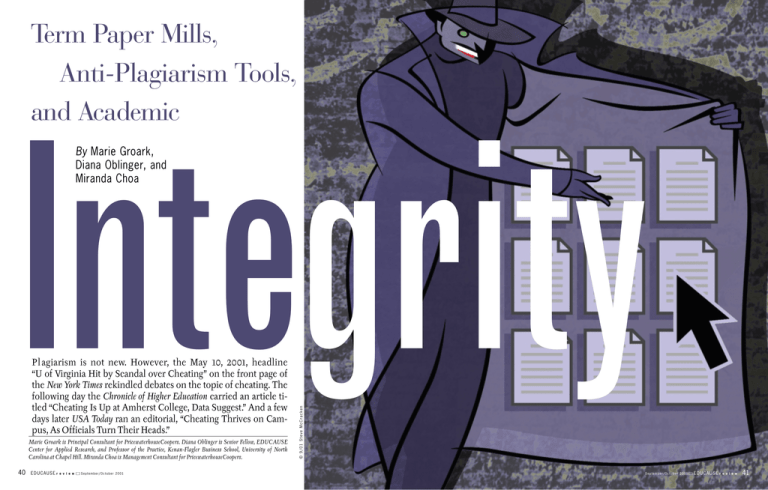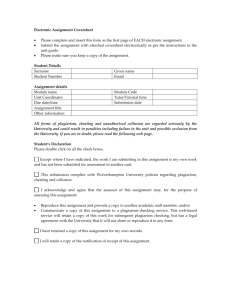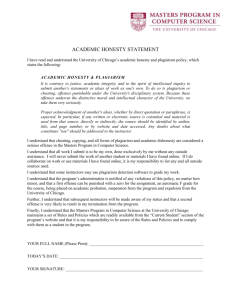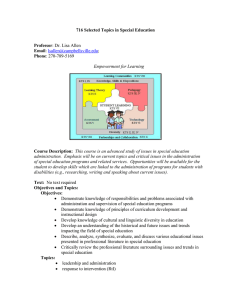Inte grity Term Paper Mills, Anti-Plagiarism Tools,
advertisement

Term Paper Mills, Anti-Plagiarism Tools, and Academic By Marie Groark, Diana Oblinger, and Miranda Choa Pl agiarism is not new. However, the May 10, 2001, headline “U of Virginia Hit by Scandal over Cheating” on the front page of the New York Times rekindled debates on the topic of cheating. The following day the Chronicle of Higher Education carried an article titled “Cheating Is Up at Amherst College, Data Suggest.” And a few days later USA Today ran an editorial, “Cheating Thrives on Campus, As Officials Turn Their Heads.” Marie Groark is Principal Consultant for PricewaterhouseCoopers. Diana Oblinger is Senior Fellow, EDUCAUSE Center for Applied Research, and Professor of the Practice, Kenan-Flagler Business School, University of North Carolina at Chapel Hill. Miranda Choa is Management Consultant for PricewaterhouseCoopers. 40 EDUCAUSE r e v i e w September/October 2001 © 9/01 Steve McCracken Integrity September/October 2001 EDUCAUSE r e v i e w 41 Figures from around the country are drawing attention to the issues of cheating, plagiarism, and academic integrity: ■ ■ ■ ■ ■ At the University of Virginia, 122 students were accused of cheating on term papers in introductory physics; half may face expulsion or loss of degrees awarded in earlier years.1 Cases of suspected cheating and plagiarism at Amherst College averaged five a year from 1990 to 1998 but increased to sixteen in 1999 and nineteen in 2000.2 Reported occurrences of academic dishonesty at the University of California– Berkeley doubled between 1995 and 1999.3 In a recent survey conducted by Donald McCabe, founder of the Center for Academic Integrity at Duke University, 72 percent of high school students reported one or more instances of serious cheating on written work, and 15 percent of students reported submissions of papers obtained “in large part” from a term paper vendor or Web site.4 A study by the Center for Academic Integrity found that almost 75 percent of college students own up to some form of academic dishonesty.5 dents surveyed, 17 percent of the students said they had cheated on tests and 44 percent said they had cheated on class assignments.6 The amount of cheating appears to be increasing. For example, at medium-tolarge universities, the percentage of students who said they collaborated on assignments even though it was not permitted increased from 11 percent in a 1963 survey to 49 percent in 1993. For thirty-one small-to-medium institutions, unpermitted collaboration increased from 30 percent to 38 percent between 1990 and 1995.7 Furthermore, the ease with which information can be copied from the Web and the emergence of term paper vendors or “mills” on the Internet are likely adding to the growing problem of plagiarism. For example, a neurobiology professor at the University of California–Berkeley found that 45 of 320 students in his class had plagiarized at least part of their term paper from the Internet. Nearly 15 percent of his students plagiarized even after they had been warned that he would use anti-plagiarism technology.8 In a recent survey commissioned by Knowledge Ventures, an education integrity is an issue on their campus. Most were unable to pinpoint the extent of the problem, the source of the problem, or whether specific departments or student groups were more at risk. In addition, of those who stated that academic integrity is an issue, 83 percent said that it has become more of an issue over the last three to five years, primarily due to the use of the Internet as a research tool. Compounding the effects of the Internet are difficulties in proving violations and a reluctance to report violators.9 There is no current estimate of the number of sites, although some lists of Internet paper mills are maintained by academic groups (e.g., <http://www.coastal. edu/library/mills2.htm>). These sites attract secondary school students as well as college and university students. They are also not exclusive to the United States. The growing number of term paper mill sites on the Web attest to their popularity among students. Term Paper Mills ■ Term paper mills existed long before the Internet. Companies who sell term papers have advertised on campus and in magazines such as the Rolling Stone for several years.10 With the advent of Internet technology, though, the number of places where papers are available has grown and the ease with which papers can be obtained has increased. Some of these Web sites are operations set up by students while others are for-profit ventures. At term paper mills, students can directly purchase pre-written papers. Some sites offer free services or make money ■ ■ ■ AP Business wire reports that traffic to these sites exceeds 2.6 million hits per month. Cheater.com has 72,000 members and is growing by a few hundred per day. With 9,500 papers in its database, the Evil House of Cheat reports 4,000 visitors a day. Schoolsucks.com, which claims 10,000 visits to its site per day, reports being profitable “from Day 1.”13 Institutional Attitudes toward Academic Dishonesty Although academic dishonesty is believed to have increased in the last two decades, it is not clear that the number of infractions reported by professors has risen as well. In a survey of 800 faculty fortable on a bridge designed by an engineer who cheated her way through engineering school? Would you trust your tax return to an accountant who copied his exam answers from his neighbor?”16 Once an instructor suspects plagiarism, it can be a laborious process proving that plagiarism has actually taken place. Instructors may need to comb through old papers and primary and secondary resources and compare the suspicious paper to these sources. Tracking down a student’s sources and proving plagiarism can take days. Those who have used an automated plagiarism tool cite the streamlined process as one of the primary advantages of the tool. But most important, papers plagiarized from the Internet and identified by an anti-plagiarism tool often provide an open-and-shut case. Tools to Ensure Academic Integrity Several vendors provide tools designed to ensure academic integrity (or to identify cases of suspected plagiarism). These tools can be differentiated on the basis of several features. For example, some vendors offer users the opportunity to download their proprietary software and grant a oneperson license to use the software as an anti-plagiarism device for an unlimited two days. The following examples of specific vendor products illustrate how they function, as well as which features differ. iParadigms has developed a search engine, iThenticate, that is able to clearly identify matching texts between two textbased documents of any language or size. The search engine examines a chunk of text, eliminates words that are too common, and turns the other words into numbers. It also converts Internet content into numbers. Consequently, it can compare patterns of numbers from the sample with patterns of numbers from the Internet. To do this, the search engine uses a number of complex mathematical algorithms. iParadigms’ search engine is used at Web sites that monitor plagiarism (e.g., Turnitin.com) and at a Web site focused on media such as movies and music (Slysearch.com). The initial site, Plagiarism.org, now serves as a Web resource about online plagiarism. Originally, Plagiarism.org was created to screen for Internet plagiarism at the University of California at Berkeley. It drew national attention when a study found that up to 15 percent of students were copying online material and using it in term papers. When demand for the anti-plagiarism technology exceeded the In most states, it is illegal to sell papers that will be turned in as student work. ■ 42 At Penn State, despite the fact that faculty had discussed the consequences of cheating with 63 percent of the stu- EDUCAUSE r e v i e w September/October 2001 technology company, more than 90 percent of academic administrators and faculty interviewed said that academic through advertising. Others act as an exchange—a student must submit a paper to get a free paper. Most term paper mills charge a fee, ranging from about $5 to $10 per page. Students may pay an additional fee for immediate e-mail delivery (e.g., $15). Other sites will write a customized paper for a much higher fee. In most states, it is illegal to sell papers that will be turned in as student work.11 Thus many for-profit sites post disclaimers saying that the information should be used only for research purposes and should not be submitted as a student’s own work. The companies will bill a student’s credit card using an unrecognizable company name. Experts estimated that more than 70 term paper mills were in operation in early 1998, up from 28 at the beginning of 1997.12 members who were asked why they ignored possible plagiarism violations, professors cited inadequate administrative support as a primary factor.14 Research by Donald McCabe has indicated that there is an inverse correlation between the rate of plagiarism and the emphasis on academic integrity by institutions or instructors.15 Thus a growing number of institutions are addressing academic integrity through honor codes, pledges, and discussions of ethics. One political science professor at Oakton Community College, for example, gives his students a six-page letter spelling out his expectations of them, as well as his obligations to them. In the first page he asks: “Would you want to be operated on by a doctor who cheated his way through medical school? Or would you feel com- number of users. Those vendors that do not have downloadable software use an Internet-based application. Fees are also handled differently by different vendors. Some charge users by the paper; others charge for a specific time period; a few change a one-time-only fee. Another important distinction among many vendors is the databases they search. Vendors’ search engines typically match submissions against a proprietary database containing company-specific content. These databases may contain other student submissions and papers from term paper mills or other sources. In addition to databases, some vendors’ search engines match submissions against content found on the Internet. Finally, the amount of time it takes to process a search varies as well. Times range from less than an hour to site’s ability to provide it, a second site, Turnitin.com, was created. This site now provides access to the iThenticate technology through a Web front-end.17 Turnitin.com is iParadigms’ portal for registered users of the company’s services. Registered users may include both faculty and students. Students who have completed assignments and want to be sure that they have not inadvertently missed citations can submit papers to Turnitin.com. Faculty may also direct students to submit papers to the site. At Turnitin.com, students or instructors submit papers that will be tested against the Internet or proprietary databases for plagiarism violations. The company believes that the recirculation of term papers is a key source of plagiarism; therefore, its September/October 2001 EDUCAUSE r e v i e w 43 database contains student papers, papers posted online, material from academic Web sites, and documents indexed by major search engines. Its database consists of 800 million Internet pages and more than 100,000 papers. Student papers submitted by registered users are also archived to the database. Thus, extended use of the service will build an instructor’s archive of papers and will ensure that students cannot easily recycle papers from previous classes. If an instructor is interested in “testing” a paper for plagiarism, he or she submits it for processing through the proprietary search engine. Once the process is complete, an originality report indicates the probability (in terms of a percentage) of whether the paper was plagiarized. Instructors can click on links to direct them to the source of the possibly plagiarized material. This process takes twenty-four hours on average but can take up to two The company has developed a fourtier pricing structure: an individual instructor can opt for a plan that provides 100 originality reports for $100 per semester. A department with no more than 50 classes can choose a plan that provides 500 originality reports for $650 per semester. A small institution with no more than 150 classes per semester can get 5,000 originality reports for $1,750 per semester. Finally, a large institution can receive an unlimited number of originality reports for $4,000 per semester. Another vendor is EVE2 (Essay Verification Engine), anti-plagiarism software that instructors may license for a onetime fee and download to their hard drives. A user may submit a paper in .txt form, and the software will search the Internet, including term paper mills, for results. Although the software is targeted at all educational levels, most users seem to be high school teachers. two hours for processing. This time is in part linked to the power of the user’s hard drive. Once the search is complete, the instructor is given a full report on each paper that contained suspected plagiarism, including the percentage of the paper plagiarized, an annotated copy of the paper showing all plagiarism highlighted in red, and links to the plagiarized sites. The report does not distinguish which sentences have been plagiarized from which sites. There is a fifteen-day free trial of the software, after which time a customer may purchase a license to the software for $19.99. New companies are planning to enter this market as well. One is Knowledge Ventures, headquartered in Boston, which underwrote portions of the research for this article. Knowledge Ventures is developing a suite of tools and middleware components for use in textto-text matching applications. CiteMaster, An instructor interested in “testing” a paper for plagiarism can submit it for processing through a proprietary search engine. days, depending on the length of the text and the level of demand. Turnitin.com was designed to provide users with a simple process for submitting papers for a plagiarism test. A user completes a short form to submit the paper. The user identifies institution, department, course, name, and ID number. Then the user may submit the paper for testing by pasting a text-only document onto the Web page. 44 EDUCAUSE r e v i e w September/October 2001 As noted, an instructor must convert papers to .txt format and submit the text to the software (which has been downloaded to his or her hard drive). EVE2 then examines the papers and makes a large number of searches of the Internet to locate “suspect” sites. Once suspect sites have been located, EVE2 visits all of these sites to determine if they contain work that matches the paper in question. Searches require fifteen minutes to the first application to incorporate these tools, will use supercomputer processing power to compare submitted text documents against the content of a proprietary academic database of textbooks, journals, Web content, and student-submitted papers. Through the use of customized algorithms and a parallel-processing platform, CiteMaster should be able to detect both verbatim and inexact text matches and to return results in real time. For each student-submitted paper, a dynamically generated “report” will be returned to a Web browser, including an HTML reconstruction of the original query document and relevant statistical information about the matches found. Matching or “suspect” sentences will be clearly identified in the text, with their proper citations listed accordingly. CiteMaster is in the early stages of development, however, and is not yet commercially available. Lastly, other vendors focus on the fact that patterns of words in documents can be used for more than detecting plagiarism. For example, WordCHECK Systems promotes KeyWORD software as helping ■ ■ ■ ■ legal researchers identify, archive, and track legal decisions by specific judges and court jurisdictions; grant-writers track keyword patterns in more effective grant proposals; political scientists find keyword profiles of political communications made ■ by candidates and officials in speeches, press releases, and opinion papers; corporate information officers identify, archive, and track keywords in e-mail to ensure the protection of proprietary information; and market researchers develop better qualitative information by tracking keywords found in focus groups and surveys.18 Implications for Higher Education The amount of time that students spend online has steadily increased, with the bulk of that time b eing sp ent on academic pursuits. With the growth in students’ use of the Internet and the attitude that information should be “free,” it is perhaps not surprising that incidents involving plagiarism have also increased. However, not all plagiarism can be attributed to the increased use of the Internet. In a study of 4,500 students from twenty-five high schools, 54 percent had used the Internet to plagiarize. But the research also showed that the majority of those cheating would have plagiarized without the Internet. Only 6 percent of those who submitted plagiarized work had relied solely on the Internet.19 As without a citation was wrong. In addition, 22 percent of students in the study turned in an assignment done by their parents. Another poll found that 66 percent of students said that cheating “didn’t seem like a big deal.” Sixty-six percent of their parents agreed.20 In addition, in focus groups involving high school students, many agreed with the following statement: “Many of our teachers are clueless when it stances of suspected plagiarism without providing a more developmental remedy may not provide a long-term solution. For example, a major factor determining whether or not a student will cheat is the academic culture of the specific institution that he or she attends. At the fewer than one hundred institutions with robust academic honor codes in place—institutions where students pledge not to Another poll found that 66 percent of students said that cheating “didn’t seem like a big deal.” technology continues to change, so do the options for cheating. Information may be stored on calculators, for example, and e-mails can be sent via palm-held devices. Will plagiarism increase as today’s high school students enter college? If existing attitudes are an indicator, it might. In a survey by Who’s Who among American High School Students, 84 percent of students said cheating was common in their high schools. According to studies by Donald McCabe, less than half of the students surveyed felt that copying a few sentences 46 EDUCAUSE r e v i e w September/October 2001 comes to the Internet, the material you can find on the Internet is of sufficient quality to submit on your assignments, and paper topics are usually so broad that your teachers are not at all likely to recognize a source you might use.”21 Although the anti-plagiarism tools currently available can search for instances of suspected plagiarism, this plagiarism-screening approach is not always integrated with other activities, such as the discussion of ethics and overall academic integrity. Identifying in- cheat and where they play a major role in the judicial process—significantly fewer incidents of cheating occur. Size of the institution does not seem to matter. Recent evidence shows that cheating can be reduced, even on large campuses, with strong honor codes and a focus on academic integrity.22 When students are frequently reminded that their institution places a high value on academic integrity, and when this value is reinforced by the campus community, the incidence of cheating is lower. September/October 2001 EDUCAUSE r e v i e w 47 Campuses have responded to the academic integrity issue by taking the following actions: ■ ■ ■ ■ ■ ■ Increasing the emphasis on the institution’s honor code. This may include requiring that freshman sign the honor code or discussing the issue with students. One university gives all incoming students a CD-ROM that provides an overview of intellectual property and copyright issues. Forming student groups to monitor and promote the honor code. A handful of institutions have created student groups that are responsible for promoting academic integrity on campus. These groups may make presentations about the importance of academic integrity to students, for example, or may convene workshops about academic integrity. Rewriting student guidelines. Many campuses have rewritten student guidelines to emphasize academic integrity. Establishing an academic integrity office. Some campuses have formed offices of academic integrity. These offices may provide an annual review of the status of academic integrity on campus, develop a forum to address issues of academic integrity, and/or oversee a faculty-student council designed to resolve incidences of academic dishonesty as they arise. Convening faculty workshops aimed at more effectively addressing the issue in classrooms. Faculty may be unaware of the growth of academic dishonesty on campus or of specific techniques that can be used to combat this issue. Many campuses have convened workshops and lectures specifically designed to teach faculty how to identify and deal with academic dishonesty. Utilizing technology-based tools. Some campuses use these tools to find and verify suspected cases of plagiarism. It is not just cheating by students that appears to be on the rise today. The pressures and opportunities for dishonest behavior are increasing in many academic and professional contexts, ranging from using term paper mills to falsifying credentials to fabricating research results. Academic integrity is a fundamental ten- 48 EDUCAUSE r e v i e w September/October 2001 ant for higher education. Both higher education and society benefit when college and university integrity standards provide a lifelong foundation.23 Although technology tools have a role to play in this mission, higher education must find the solution to academic integrity problems through an integration of technology, policies, and personal interaction. e Notes 1. Diana Jean Schemo, “U of Virginia Hit by Scandal over Cheating,” New York Times, May 10, 2001. 2. “Cheating Is Up at Amherst College, Data Suggest,” Chronicle of Higher Education, May 11, 2001, A11, <http://chronicle.com/weekly/v47/i35/35a01103. htm> (accessed July 12, 2001). 3. “Cheating Thrives on Campus, As Officials Turn Their Heads,” USA Today, May 21, 2001. 4. Donald L. McCabe, “Student Cheating in American High Schools,” May 2001, <http://www.academic integrity.org/index.asp> (accessed July 12, 2001). 5. See <http://www.academicintegrity.org/cai_ research.asp> (accessed July 12, 2001). 6. See <http://www.sa.psu.edu/sara/pulse/ academic.shtml> (accessed July 12, 2001). 7. See <http://www.academicintegrity.org/cai_ research.asp> (accessed July 12, 2001). 8. Verne G. Kopytoff, “Brilliant or Plagiarized? Colleges Use Sites to Expose Cheaters,” New York Times, January 20, 2000. 9. This survey was conducted in February 2001 by PricewaterhouseCoopers on behalf of Knowledge Ventures. 10. Peter Applebome, “On the Internet, Term Papers Are Hot Items,” New York Times, June 8, 1997. 11. Ibid.; see also Ronald B. Standler, “Plagiarism in Colleges in USA,” <http://www.rbs2.com/plag. htm#anchor333347> (accessed July 15, 2001). 12. John N. Hickman, “Cybercheats: Term Paper Shopping Online,” New Republic 218, no. 12 (March 23, 13. 14. 15. 16. 17. 18. 19. 20. 21. 22. 23. 1998): 14, <http://www2.bc.edu/~rappleb/ Plagiarism.htm> (accessed July 23, 2001). Kendra Mayfield, “Catching Digital Cheaters,” Wired News, February 29, 2000, <http://www. wired.com/news/print/0,1294,33021,00.html> (accessed July 12, 2001). “Why Professors Don’t Do More to Stop Students Who Cheat,” Chronicle of Higher Education, January 22, 1999. “New Research on Academic Integrity: The Success of ‘Modified’ Honor Codes,” College Administration Publications, <http://www.collegepubs.com/ref/ SFX000515.shtml> (accessed July 12, 2001). Bill Taylor, “Integrity—Academic and Political: A Letter to My Students,” <http://www.academic integrity.org/pdf/Letter_To_My_Students.pdf> (accessed July 12, 2001). See <http://www.iparadigms.com/plagiarism. html> (accessed July 17, 2001). See <http://www.wordchecksystems.com/ applications.htm> (accessed July 17, 2001). Cara Branigan, “Rutgers Study: Web Makes Student Cheating Easier,” eSchool News Online, June 1, 2001,<http://www.eschoolnews.org/show story.cfm?ArticleID=2638> (accessed July 19, 2001). “A College Test: How to End Epidemic of Cheating Students,” Philadelphia Inquirer, April 22, 2001. “New Research on Academic Integrity: The Success of ‘Modified’ Honor Codes,” College Administration Publications, <http://www.collegepubs.com/ ref/SFX000515.shtml> (accessed July 12, 2001). Ibid. See Center for Academic Integrity, “The Fundamental Values of Academic Integrity,” October 1999 <http://www.academicintegrity.org/Values. asp> (accessed July 12, 2001). This piece is adapted from a sample research bulletin produced for the new EDUCAUSE Center for Applied Research (ECAR). For more information about ECAR, visit <http://www. educause.edu/ecar/>.




